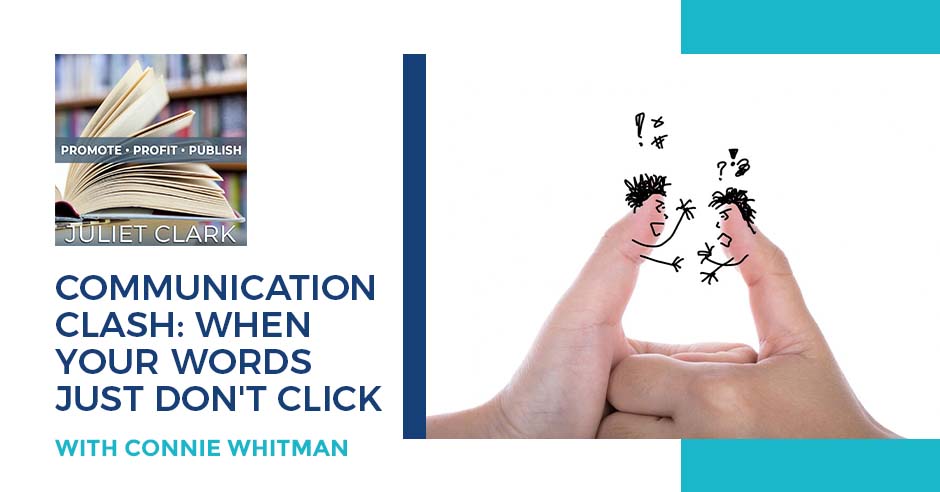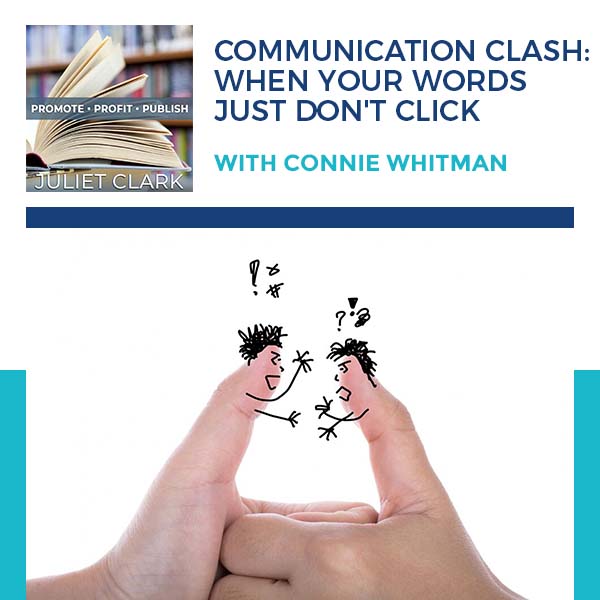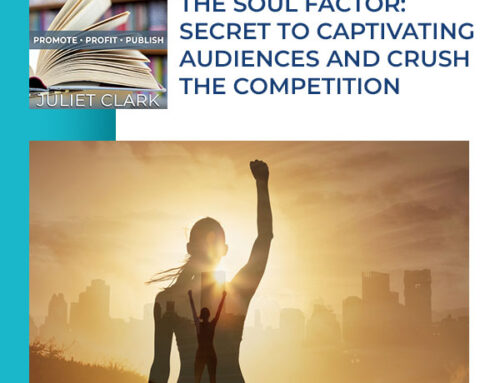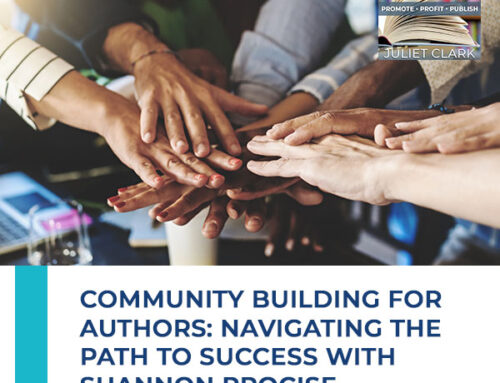
Sometimes, words just fail you. They just don’t click and grab the audience’s attention. Fortunately, we have an amazing guest who can help you overcome this communication clash. In this engaging episode, Connie Whitman, renowned for her dynamic and passionate approach to sales coaching, joins Juliet Clark for an insightful discussion on the crucial interplay between effective communication, language, and successful sales strategies. With over 20 years as the CEO of Changing the Sales Game, Connie shares her wealth of experience helping business owners, leaders, and sales teams build powerhouse organizations. As a three-time international best-selling author, speaker, and podcast host, Connie delves into the importance of understanding and adapting to diverse communication styles, emphasizing the role language plays in connecting with target audiences, and offering invaluable insights for authors navigating the realms of sales and communication. Join us for an energizing conversation as we explore the intricacies of sales, language, and the transformative power of effective communication.
—
Watch the episode here
Listen to the podcast here
Communication Clash: When Your Words Just Don’t Click
We have another great guest. I’m super excited. Before we get started, I want to remind you to go over to BreakthroughAuthorsBookClub.com. It is free. We now have a book club over on Amazon, and we have two great picks for the month of February, Laura Biswas’s The Cosmology of Love and she is a self-help love servant who loves creating love around the world.
Our other book is Samantha Kaaua’s Finding Beauty in Your Broken Pieces, which is such a dear book. I love this book because it’s all about you taking the personal responsibility for your healing in your hands to change every relationship in your life. Sam is a marriage and family counselor. She works a lot with couples, saving marriages and dysfunctional families and changing the way that people communicate with one another. It’s a beautiful thing.
Our guest is Connie Whitman. You probably know Connie from a couple of years ago if you’ve been an avid audience. She is known for her high energy and passionate, heart-centered, and enthusiastic approach to sales. Connie has been the CEO of Changing the Sales Game for twenty-plus years, helping business owners, leaders, and sales teams build powerhouse organizations. Connie is a three-time number-one internationally bestselling author, including her book, ESP-Easy Sales Process: 7 Steps to Sales Success, speaker, and podcast host. She has two podcasts.
Her inspired transformational tools and content ensure that business owners and salespeople grow their revenue streams through enhanced communication skills. She is thrilled to share her inspiring content on her international podcast, Changing the Sales Game, and in the Enlightenment of Change. She is a super dynamic person. I know her from the Dames, and she’s also a mentor as MI in the Media Magic Program with Shannon Procise. Stay tuned for Connie.
—
Connie, welcome. It’s great to have you back.
I love spending time with you, Juliet. We always have so much to talk about and so much to share. It’s how we roll.
That’s so sweet. When we talk, it’s like, “I have to go.” It’s great to have you here. I want to talk about sales and communication language because what you do well is that communication language. A lot of authors don’t understand that going into their book. They not only have to understand the language of their target audience but their language as well because you’re riding that line between connecting with that audience and being authentic. Can you talk a little bit about that?
It’s so interesting because humans have a six-second attention span, and a goldfish has a seven-second attention span. That’s a little fun fact. Not only do we have that limited attention span, but if we don’t capture whoever we’re communicating with, marketing to, or selling to, whether it’s written or verbal, in those first couple of seconds, we’re missing opportunities. We have to refine how we show up and how we’re very strategic in how we communicate, specifically to whoever our target market is for the book or whatever it is that we’re writing. That is the most important thing. We’re in trouble.
The other thing is we have different filters throughout life. You have the model that you teach your authors. I have a communication style assessment, which we will talk about during this episode. There are other filters that we gain through life. An example would be when you’re born, the wiring of your brain is a certain way. I’m going to keep this super simple and say that if you’re an introvert, you are born an introvert, and you probably will die an introvert. If you’re born an extrovert, you will die an extrovert. Our brain wiring doesn’t change. We can work on it and enhance our communication, but the core of our bench strength doesn’t change like our blood type. That’s foundationally number one.
We have different filters throughout life. Share on XThe second thing is men and women communicate from a different perspective. If my audience is predominantly women, I have to approach from a more nurturing and emotional conversation. There’s a lot that goes into this, but I’m giving the tip of the iceberg here. Men usually want a little more analytics or proof of what you’re saying, selling, or whatever it is. You need to know what is charging the men and women in your audience under the surface. That’s the second one.
The third one is where you grew up. If you grew up on a farm or in an inner city, you have filters that you see the world or perceive the world from that frame of reference. None of these are good or bad, right or wrong, or better or worse than the other. They just are. If I was raised on a farm, I’m going to approach life and the information I’m hearing differently than someone who grew up in an inner city. Location, environment matters and how you were raised or the traditions you were raised in matters.
In the United States, we are the melting pot. Our whole premise of the United States was immigrants coming in, moving across the country, and what have you. I was raised in a very Italian household. My dad landed here when he was twenty years old. A lot of how I approach life, and I don’t even realize it, is because of his influence from when he was over in Italy versus my peers. Their parents grew up in America. Plus, they grew up in America. Their perspective is very different than mine. Those traditions and heritage things affect our filters. That means it affects our target audience or whoever we’re speaking to.
The other one is generation. If you’re speaking predominantly to an older generation, you see it. There are five generations in the workforce working side by side, which is a beautiful thing. Think of the richness and the dynamic of information. I can learn from younger people. Younger people can learn from you and me or peers like us. We have a lot of mileage, knowledge, and wisdom. We might not be as good as them in new things that are coming up innovatively in the technology world.
Who’s in my audience? I need to know where to come from. Is it more tech? Is it more of the old-fashioned way of thinking? All these filters impact not only me, the individual, but you need to know what’s going on in your filters because what’s being landed or how people are receiving it matters, whether we sell books, programs, or whatever it is that we’re doing.
A lot of times, when the newbies in our industry come, they don’t know how to write copy. They don’t know how to do all this, and they don’t think about who’s receiving that information. That’s a lot of what ends up being wrong with marketing. I have a basic structure I work with. I don’t teach BANK. I want to say that right off the bat. I’m not certified in BANK, but this is a great book for beginners in marketing because it helps you understand where you fit in and where the clients fit in. What is offensive? Who are you talking to when you’re talking to people? You have a different one that you use. Can you tell us a little bit about what you use and how that works?
I’m certified in DISC, which is very similar to BANK. I have a colleague of mine who’s certified at Myers-Briggs. One day, we were collaborating on something, and I said, “I love DISC.” People come into my classes and go, “I’m an SC. I don’t know what that means.” If you don’t understand what something means, how can you use it? She felt the same thing with Myers-Briggs, “You’re an EINJ.” What does that mean after the fact? Understanding information is great, but then applying it to real life becomes a whole other layer of usage. If I learn something, I want to be able to use it and get some application or repercussion from whatever that effort is that I’m putting out.

Connie Whitman: Understanding information is great, but then applying it to real life becomes a whole nother layer of usage.
Thousands of people have been through this model. We came up with five styles and did a couple of things different than a DISC or a Myers-Briggs. We think that 20% of the time, 2 out of 10 people that we speak with speak like us. You don’t have to modify, think, or second-guess yourself. Talk. People get you 20% of the time. That means 8 out of 10 people we’re speaking with speak opposite or differently than us. We think we’re being clear with our message, but they’re not receiving it the way we anticipated it coming out of our mouth, in written form, or whatever it might be.
That’s the framework. Think about it. Twenty percent of the time, communication is easy peasy. Eighty percent of the time, we’re going the uphill battle. The other piece of the puzzle when we put this together is it had to have a positive resonance or vibration to the title because people will embrace their strengths with that style and be more open to seeing potential blind spots.
I remember when we first rolled this out, and I did a speaking event. There were 500 people in the room, and people didn’t know me. I was the keynote speaker. They were coming in when we still did it live. This was probably back in 2019. Juliet was adorable. They were like, “I’m a heartfelt advocate.” They didn’t even know what it was. They get this little one-paragraph report. I haven’t spoken yet, and I giggled. I’m like, “I could see you’re a heartfelt advocate.”
The heartfelt advocate is the first one. They lead and live through their heart. They wear their heart on the sleeves. We’re all thinking of someone, friends, and family that falls within that realm. They are your most loyal friends. They like changes the least. If you’re writing a self-help book, and your audience are heartfelt advocates, they’re going to need a little coddling. They’re going to need a little bit of reinforcement because they’re going to be like, “What if?” That element of change throws them.
Additionally, if you’re helping them move through something that’s a deep-rooted hurt for them, that hurt keeps rearing its ugly head. The wound keeps opening for them. It takes them longer. If you’re selling to heartfelt advocates, for example, I always say, “You’re probably not going to make the sale in the first conversation because they need to percolate on it. They need to see how it’s going to resonate with them. They have to check in with their heart.” That’s the heartfelt advocate. Do you have any questions about that one? I’ll go through the others.
That sounds right on. What I read in the BANK book that I have people read is there are going to be things that you say that resonate, and then there are going to be things that you say, if you’re not careful, that repel. I talked about that a little bit with the knowledge, “What makes the sky blue, Mommy?” They’re great at being engineers and building bridges, but if I had to build a bridge, I wouldn’t drive on it. I’m not analytical. You have to understand. When you’re talking to those types of people, they’re not going to commit on that first call. They’re going to be the heartfelt advocates. They’re going to walk away, think about it, and then come back. Knowing this helps you understand how to close the deals.
It’s a behavioral style. It’s more of how we behave or receive information versus a personality. We have two. The first one is a precise assessor. Precise assessors are the engineers. They’re the ones who can sit, analyze, and know whether that calculation is off. The bridge in your example would collapse. They’re the precise assessors. They like precision. They seek that perfection because they know what they’re creating. They could be deaths if they don’t create a bridge that’s sustainable or a building that’s not going to collapse. That’s the precise assessor.
The blind spot for our precise assessors out there is that subconscious realm that we have to be mindful of. If you’re selling to engineers, architects, and computer programmers, that underlying is they’re socially awkward. When you approach them and ask them a question, they want to answer with such detail and thoughts back at you. I’m not a precise assessor. Neither are you. We ask a question and think, “They didn’t understand that question. Let me ask another question.”
We rephrased it and then asked a third question because they were so slow to respond and were trying to answer thoughtfully. They look at you and say, “You’ve asked me three questions. Which one would you like me to answer first?” That’s a disconnect. We think, “They didn’t understand the question.” They’re percolating because they want to answer with detail and thought. That’s a precise assessor. They want you to understand everything that’s going on in their head, but it takes them a lot longer to fire that information out to us because of the precision.
If you think about those engineer types, they’re assessing. That’s what they do. They’re assessing every possibility. It’s a patience thing. I had a client back when I sold real estate who owned a big aeronautical engineering company. He asked me, “What happens if a fire starts on that hillside?” I’m like, “How would I know that? Should we get some matches and start one?” That’s how they process, “What are all the possibilities here?” That doesn’t compute with me.
It’s funny because I work with a lot of authors, too, because they’re on my podcast. We promote their book, and then I might do a show with them later on saying, “How was your book received? What was the repercussion after people applied your ideas, thoughts, or whatever it was?” Sometimes, they come back and say, “I was shocked. Do you know that engineers found value in my book? I was talking to salespeople.” It’s this reverse pattern interruption, “Who’s my audience?”
That’s interesting, too, because sometimes we create something that we think is going to resonate with style X. Meanwhile, all of a sudden, word gets out, and it’s resonating with people we never even thought would enter our orbit. It’s almost by accident, but let’s say that does happen. How do you shift? That becomes a profitable target audience or target market. How can we tap further into that? That’s our communication refinement. We leave less money on the table because we’re capturing more because we are refined in how we’re showing up for fill-in-the-blank.
Through communication refinement, we leave less money on the table because we're capturing more. Share on XHere’s the other thing, too. When you write a book, you go to a speaking event to promote the book. There are a lot of extroverted engineers. They’re talking from different frames of reference than you as the author. When you present, you want to make sure of your flow, how quickly you speak, how slowly you speak, and how animated you are versus how calm you are. You want to blend all of those in because of that audience, especially if it’s over ten people. You probably have 5 out of 5 of the different communication styles.
I’m going to shift it a little bit. A lot of times, when we work with clients, we will go over and look at their LinkedIn profiles. You and I both work with Shannon Procise. She will go over and look at YouTube, “What’s going on YouTube before our press releases are released?” A lot of times, a coach will hire a company to write their bios or something like that. When you look at the language in the bio, it doesn’t match the person they’re writing it for. It matches the writer’s style.
People are left wondering, “When they read my bio, why aren’t they resonating with it? Why aren’t they resonating with what I’m saying over on YouTube?” A lot of times, it’s because the person who wrote for you didn’t understand the audience the way it should be. We do a lot of correcting with that. She has a fabulous website that you can take a copy of and run through her AI, and it will tell you who you’re speaking to. When I go over and show that to people, “This is why your copy is not working,” they’re stunned. They have no idea.
In this AI stuff, there’s so much good. Be careful because you don’t want it to write for you because it still has to be your voice, even though the AI does a pretty good job of that. I love these AI tools. That is a brilliant application.
What she did is a brilliant application of it, but people don’t understand the words. Tell us about some of the others. You have five main ones. You’ve gone over two.
The other one, similar to the precise assessor, is the observing designer. They’re good at going down the rabbit hole. There are true innovators out there, but they’re like absent-minded professors. They never finish because they’re always in their heads. They’re always doing more research. They go down the rabbit hole, and all we see are their feet sticking out. They need someone to give them a lifeline to pull them out. Where the precise assessor could take a lot of data, digest it, and synthesize it into a report, the observing designers say, “There’s more. Let me look at that link. Let me look at the next link.”
They could be very unproductive. They, too, might not make a decision because they’re going to say, “I’m going to look into that topic and do research before I buy that book.” Meanwhile, six hours later, they’re still doing research. They will almost say to themselves, “Where did I start? Why did I go down this rabbit hole?” They don’t remember. It was to analyze whether they wanted to buy your book or not.
That’s the observing designer. They’re also socially awkward. They’re not going to have great social skills typically, but they want that research. They love going down that rabbit hole. It’s not just synthesizing information. They love the intensity of reading. You better be prepared. Maybe have a little more copy if you’re observing designers because they want more of that analytics. They need proof that you’re going to help them with whatever your zone of genius is. They’re a little bit different than the precise assessor.
The next one is the innovative organizer. I call them the CEO mentality. They’re good at decision-making. If they think your book is cool, within two seconds, they will buy that book. They’re going to jump at the opportunity. They’re not going to read a lot of copy. They don’t need a lot of analytics, “Give me three facts, and I will make a decision right here.” You have to be more brief with them. Your pace should be a little bit faster because they’re onto the next thing. Think of a CEO. They have multiple balls in the air at all times. Don’t bog them down with data and analytics, “Give me three words. What do you want me to do? Why should I do it? Let’s go forward and do it.”
The blind spot for the CEO mentality or the innovative organizer is they think to themselves, “I know better than you.” Meanwhile, what you’re trying to sell them or the book you’re offering them is exactly what they need. There could be a little bit of an ego there. Sometimes we have to follow up with them to make sure that they understand what we’re all about, but if you give them too much analytics, they’re like, “That’s boring,” and they’re onto the next ball or whatever it is that they need to do in their lives or their businesses. That’s the innovative organizer.
That’s a little like me because I’m not detailed. Give me the highlights, the pluses, and the minuses, and then I’ll make a decision but I’m not going to do most of the research myself.
I’m going to ask you to guess what I am at the end. You will be able to tell easily which two. There are two that I scream. If I’m giving you too much information with the six-second attention span of a human, you’re tuned out. You are long gone. You’re not even part of that conversation anymore. The other thing you want to make sure of is if an innovative organizer says, “I’m looking at you, your program, or whatever it is that you offer,” you have to make sure that you hit them hard and be very direct because you want them to make the decision. They’re either going to make no decision or haphazardly make a decision. You might not be the choice. Hit them between the eyes. Hit them hard and fast, and they will make a decision. The funny thing is they will like that about you because you’re not wasting their time.

Connie Whitman: With an innovative organizer, you want to hit them between the eyes hard and fast and they will make a decision.
The last one is the stimulating motivator. The stimulating motivator. It’s a little bit like the innovative organizer. They move fast. They think fast. They will make a quick decision, but there has to be an inspiring message behind that. They want to share inspiring messages. They want to support you as the author of your book. If stimulating motivators like your book, they’re telling 100 of their friends. They’re saying, “Give me your affiliate link. I want to promote this book. It changed my life.”
They are the rah-rahs out there. They move fast. You have to be careful because sometimes they’re moving forward, and they can leave a wake of angst behind them because they think they’re being inspirational. Meanwhile, I’m saying, “Send me links. I have to get this out.” I’m putting pressure on you because you have other things that you had planned for your day, but I’m making it sound like I need it immediately. That stimulating motivator could create angst behind them. They’re the five styles. You have to know who you’re talking to. What do you think my top two are?
It’s the second to the last one.
It’s the innovative organizer or the CEO.
I would have thought it was the last one, but you don’t ever leave me with angst.
Let’s talk about that. I am the second one. On my scale, it’s a 50 to a negative 50. You fall within that realm, and that’s the intensity of your style. My stimulating motivators are 50 out of 50. When I coach and teach, I want everybody to succeed and make $1 million. I’ve got your back. That’s who I am, and then there’s the innovative organizer with a 38 score, which is pretty intense. It’s like, “Enough of the tomfoolery. We have work to do. Let’s go.”
That is me. We had a discussion earlier about these people who do their homework. If your homework isn’t done, I am like your mom, “Sit down. There’s no snack for you and no play. There’s nothing.”
In 40 years in sales, 30 in coaching, and 22 in business, do you know how many people I have met and trained? 20,000, 30,000, or 40,000 people during that timeframe. It’s a lot of time. People later on will say, “When I first met you, I was very intimidated.” This is my response every time, “You’re intimidated by me. Are you freaking kidding me? I want everybody to win. If you need me, I’m there for you.” They go, “You’re a little intense.” I go, “I am.” It’s so funny how we don’t see what we’re putting out there that people are picking up. The people who say that to me are the heartfelt advocates.
I would think that because even when you go into the basic BANK that I tell people to read, those nurturers don’t move that quickly. In BANK, I’m an action and then a blueprint because of the action-oriented organization. I’m a little bit of the nurture. What’s interesting is there is a guy, and I wish I had done some prep and knew his name. He has something very similar to BANK. It’s four personalities. You take these personalities and put them in order.
I had the opportunity to sit at his table at an event. I’m going to do it in BANK terms because I don’t remember his, but it’s action, blueprint, nurture, and then that K. There was something about the last one that I had to ask him, “Is this something from my childhood?” He was like, “More than likely, yes. We haven’t explored that a great deal, but a lot of times, that one where you don’t communicate with is something that went on in your childhood that backed you up. You put up blocks from it.”
I always thought that was interesting. He had me take the cards right at the table, and he said, “Describe your mother with these cards. Describe your father with these cards.” We were sitting there and testing it, “What would you say the order is for your mother? What would you say the order was for your father? What is it for you?” It was an interesting exercise. It was very thought-provoking for him because nobody had ever asked him that before. He was like, “There’s some validity there too.”
That’s what we talked about before we started the recording. With all of these style things, BANK, whatever predictive index, or Myers, if somebody says to me, “You don’t have an assessment,” I go, “Give it to me.” I want to peel back that onion because sometimes we all have blind spots. You don’t know what the blind spots are because they’re blind spots.
If someone gives me BANK because I’ve taken BANK too, I think, “It’s not a surprise,” but there might be a sentence where I’m like, “No one has ever said that. That’s interesting.” You should always explore the self. Develop self. That personal growth is so important because you never know what you’re going to learn from that next model that you take. It reinforces “That it is my strength. That is my blind spot. I forgot about that blind spot. I was working on it. I stopped working on it.” It brings it full circle.
Here’s the other thing you said that made me think of something. I’ll use DISC. Years ago, someone said to me, “Are all of your friends IDs or DIs?” They are like us. They’re very direct. They move fast and think fast big-picture, “Please don’t get me in the weeds. I would rather put pins in my eyes.” They said, “Is everybody like you?” I thought about it. No one had ever asked that. I said, “That’s interesting. Most of the people closest to me, my husband, and my kids are all opposite of me.”
That night, I was like, “This is interesting.” This is why I personally crave what I don’t have. The sample would be if someone shares something with me, I think, “I wonder if I should use that for my business.” I’m ready to make a decision without doing any research. I’ll go to my husband, who’s a CSSC, is very detailed, loves researching, and all of that. I’ll go, “Somebody told me about this. Look it up for me. See what you think. Report back.” He will do a ton of research and say, “The price point is worth trying. Are you out of your mind? What were you thinking? You don’t need this.”
I’ve learned to surround myself with those who are opposite of me because I know that’s a big blind spot. I was craving that without even realizing it. I challenge everybody. Pay attention to who’s in your orbit. What I’ve seen is people are opposite of you because you need that balance because they cover your blind spot. It’s an intuitive thing. Isn’t that fascinating?

Connie Whitman: Pay attention to who’s in your orbit.
That is fascinating because if I think about my business, you are in my world. All people in my world are the same as me in the business.
We’re business owners.
When I was married, I was a server. He was a seller. My daughter is exactly like me. My son is not anything like me, but what’s funny is if you look at the dynamics of the familial relationship, my son is very close to me. He’s probably getting something he doesn’t have himself.
It’s interesting because my one son, who’s very much like my husband, sees us interact and sees our roles in business. He comes to us for different things with detailed emails, “Is this clear?” Don’t come to me because I don’t want to edit anything. I would rather have pins in my eyes, but he will come to me and say, “I’m thinking about approaching my boss. Should I approach it this way? I want to make sure she understands me, but I don’t want to be emotional.” I’m like, “Get your notepad out because he needs to take notes.”
It’s so interesting that they know who to go to for the information they’re seeking. I’ve been teaching my kids. I taught them DISC when they were in middle school because they had to present. I taught them about DISC and said, “You have people in your audience, your peers, that are all of these different styles. You give everybody a little bit of something so that they tap in and engage with you.” They were fascinated by this. It’s funny how they grew up with it. That’s why they know who to come to for what. Think about that, too, within your family. This is a great tool.
That is so interesting because my daughter is the youngest manager at Whole Foods. She is a bit of a hothead. I’ve taught her to take a deep breath, and then she will call me and go, “Please tell me how to handle this in a way that allows me not to kill people and lose my job.” We will talk it through. My son doesn’t have problems like that because he doesn’t have a high-pressure job. She does, but it is interesting. It’s not, “I’m going to go to Mom because I don’t want Dad to know. Mom and Dad have different skillsets.” The funny thing about my kids is my daughter is married. My son is not, and he’s older. He goes to my daughter for dating advice, and she’s like, “Why are you asking me? I dated three people and married my husband.”
That’s adorable. The other thing, too, is people listen and say, “That means I’m a heartfelt advocate. I could never own a business.”
That’s not true.
That’s a ridiculous thing. Is it going to be a little bit harder for you to say no to people? Can you do it? You have to develop that skill. I am not a detailed person. My husband has to edit everything for me. If I have a new client, and it’s an important email, I’ll give it to him and say, “Is it grammatically correct? Does it make sense?” I fire directly, “Is it enough information?” He edits it for me.
Here’s the thing. I write manuals. I could teach in detail because my dad was an engineer. From when I was a little girl having to make a decision, I would say, “Dad, what do you think?” He would say, “Let’s take notes. Write the pros and the cons.” We call Benjamin Franklin the little T. On the left side are the pros. What are the pros of that decision? What are the cons of that decision?
You’re analyzing. You can make an educated decision. Think about that. He did that my whole life. I don’t know how to think any other way. Is it intuitive for me? No. I was not born that way, but I learned it because it’s how I think now. That’s how I was taught. We can learn to maximize or cover our blind spots by seeking correct help and seeking the right people to help us.
That is so true because when I was growing up, ADHD wasn’t a thing. If you know me, I’m ADHD, all over the place. My dad taught me to make lists and be organized, and to this day, I still do that. It’s how I organize and manage everything. I probably would have been all over the place. I probably would have been on drugs like everybody else in the world.
It’s a great skill. That’s the other thing, too. We forget our parents know us. I know what my kids need. They’re very different, but I know what they both need and how I need to communicate with them. I could be very direct with one. With the other one, if I did that, he would be in a puddle in his room. He would never come out because it’s too mean for him to receive that message.
You have to understand who’s in your audience. Here’s the thing. Do we ever want to offend anyone? No. Do we want people to buy from us? Yes. I’m in sales. I hate the word convince or persuade. I don’t use those words. If you’re the right person for me, I want to make sure I’m articulating that perfectly. You’re making a very solid and sound decision, and it’s not a crapshoot because I sold you a bag of goods. You understand what you’re buying. Who am I speaking to? They understand what I’m saying. It goes down to the communication piece. It’s so important.
Where people get caught up in the sales process is that they’re not closing correctly, but they’re also giving their power away in a sense. That’s one thing I tell people all the time in the sales realm. When we have a call together, it’s as much about me deciding if I’m going to take you as if I’m going to make you an offer, and you’re going to say yes. Sometimes, we don’t have a meeting of the minds, and that’s always okay with me because it’s the universe telling me that there’s something there that wouldn’t have worked.
Once you can flip that script and come from a more empowered place where you are deciding on the call if you’re going to make an offer, and you don’t have an offer you’re going to give everybody, that flips the script and takes the desperation out of sales too. If you can reconcile, “That didn’t happen, and it wasn’t me personally. I didn’t have what fit for them, and that’s okay,” I like that too.
Here’s the thing. What you said is so important because if they’re not the right fit for you, and you do know that in your soul, they’re not the right fit. If you take them on, they’re going to take up so much of your space, time, and mental capacity that you’re going to be losing even better business over here. We end up leaving money on the table because we’re putting our energy in the wrong place.
I was in business for maybe three years. I had little babies at home. We needed income. I was just starting. It was a $20,000 contract. It was a lot of money back in the ’90s. The organization wasn’t a good fit for me. It was a company. I walked away from the business, and he was like, “I want you.” I’m thinking, “You are not the right person for me.” Thank goodness I didn’t take that business because, number one, he would have monopolized so much of my time, and it would have been more than the $20,000 of effort that I would have had to put out. More business came in because I walked away from that.
You can’t come from a place of desperation because one door closes, and another one opens, but you have to be true to yourself and you have to know if you could truly help that client. You can’t take business, “It’s money. You can never say no to a deal.” You can. Make sure it’s the right deal for you as well as for the person. Here’s the other thing. If you are the right person for me, I’m going to get referrals from you on the backend. If you’re not the right person for me, you could do some bad publicity out there for me that ends up hurting me even further than all of the effort I gave you. That’s another word of wisdom.
That’s true. Before I owned this business, I had a brokerage. I worked as a real estate broker. People were always stunned, “You fired a $1.7 million listing.” I would be like, “It should be $1.5 million. They’re not listening, and I’m done spending promo money on people who won’t listen.” Part of that is learning to set good boundaries for yourself as well as your business. Where can we find this quiz so we can find out more about what you do in communication?
If they’re like, “I’m so curious,” it’s ChangingTheSalesGame.com. Right at the top, there’s a little red button, and it says, “Communication Style Assessment.” Click on that. It will take you right to the assessment. They will get two reports. One is the highest score. It’s 50 out of 50 for stimulating motivator. To give you the highest score, you will get a report.
It’s very important to know because we want to know what our natural superpowers are because we want to lean into them and develop them even further. On the flip side, the lowest score for me is the observing designer, the one who likes to do the research and go down the rabbit hole. I have a negative 50 on that one. I have none, but that’s why I hire people to do that stuff.
You will get the lowest score, which is more important. Remember, I will never become an observing designer. I don’t want to put the effort out, “Who do I need to hire? Who do I need to show this to cover that blind spot? Who am I speaking to? That’s an observing designer.” This is an important lesson, “What do I need to do so my message lands for them properly?”
Thank you so much, Connie. This was great.
I love you. Thank you for having me.
Important Links
- BreakthroughAuthorsBookClub.com
- The Cosmology of Love
- Finding Beauty in Your Broken Pieces
- Changing the Sales Game
- ESP-Easy Sales Process: 7 Steps to Sales Success
- Changing the Sales Game – Apple Podcasts
- Enlightenment of Change – Apple Podcasts
- https://Linktr.ee/ConnieWhitman
- https://www.WhitmanAssoc.com/
About Connie Whitman
 Known for her high-energy, passionate, heart-centered, and enthusiastic approach to sales, teaching, and coaching, Connie Whitman has been the CEO of Changing the Sales Game for 20+ years helping business owners, leaders, and sales teams build powerhouse organizations.
Known for her high-energy, passionate, heart-centered, and enthusiastic approach to sales, teaching, and coaching, Connie Whitman has been the CEO of Changing the Sales Game for 20+ years helping business owners, leaders, and sales teams build powerhouse organizations.
Connie is a three-time #1 International Best-Selling author, including her book ESP (Easy Sales Process): 7-Steps to Sales Success, speaker, and podcast host. Her inspired teaching, transformational tools, and content ensure that business owners and salespeople grow their revenue streams through enhanced communication skills.
She is thrilled to share inspiring content on her international podcasts “Changing the Sales Game,” and “Enlightenment of Change.”
Love the show? Subscribe, rate, review, and share!
Join the Promote, Profit, Publish Community today:
- superbrandpublishing.com
- Promote, Profit, Publish on YouTube
- Follow Juliet on LinkedIn
- Take the Quiz!









Leave A Comment